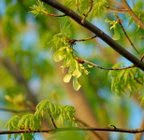Ice Storm 2007
If you have watched the news or live in Oklahoma, then you know that we had one of the most devastating ice storms in our history. Power is still off at day 4 for over 200,000 people in Central Oklahoma. Ice storms are frequent to Central Oklahoma and property damage is inevitable. I have driven through north Oklahoma City and Norman and its neighborhoods. There are some lessons to be learned from the storm.
Lauren Springer wrote a book called The Undaunted Garden Planting for Weather-Resilient Beauty. In it she discusses how plants have evolved and adapted to inclement weather common to its place of nativity. Plants have special adaptations that we should take special notice of. When we take plants out of their native systems and use them as ornamentals we are taking them out of context. If we look back at the environment in which they evolved get a much better understanding of what they can do and what their limitations are.
An example is beach plants must be resilient to wind in order to survive. Palm trees can survive hurricanes because of their lack of branches. Banana leaves can shred and still be viable because of their specially adapted vascular systems. Evergreen trees have adapted to snow loads and short summer seasons. We know that succulents can take drought and Cypress trees with their specially adapted breathing knees can grow in a swamp.
Lauren Springer's book talks about the importance of plant origins. She gives the example of the English garden and how the flowers are large and the stalks are soft because of the moderate and tempered climate. There is a reason gardeners do not grow delphiniums in Oklahoma. More importantly she talks about native plants to North America and their special adaptations. The Midwest has special weather--high winds, ice storms, temperature fluctuations, severe hail, humidity and drought. So it would seem that plants native to this climate have special adaptations suited to its unique weather.
This was very evident in our recent ice storm. Yes, Pecans and oaks fell. Most notable damage to native species was on declining trees. Young native trees that had grown to fast due to added fertilizer and care also show severe damage, especially their crowns. A great comparison is the Mexican Sycamore and the native Sycamore. The Mexican Sycamores are completely limbless and crushed. The native sycamore weathered very well loosing only a few limbs. The Lacebark Elm, a non-native were annihilated. Other elms took damage too, especially older elms, but many of the natives faired well and will recover reasonably well. Pear trees--there should be a deposit required for every pear tree that is planted. A deposit that plants good sturdy trees that survive. Many of the Redbuds didn't even sag, and the native Caddo maple faired well.
So when planting in Oklahoma do your homework. Don't plant every new ornamental that comes down the line. Look for ornamentals with roots in the Midwest or be prepared to be devastated the next ice storm or hail storm. Natives aren't immune, but they are resilient.
Lauren Springer wrote a book called The Undaunted Garden Planting for Weather-Resilient Beauty. In it she discusses how plants have evolved and adapted to inclement weather common to its place of nativity. Plants have special adaptations that we should take special notice of. When we take plants out of their native systems and use them as ornamentals we are taking them out of context. If we look back at the environment in which they evolved get a much better understanding of what they can do and what their limitations are.
An example is beach plants must be resilient to wind in order to survive. Palm trees can survive hurricanes because of their lack of branches. Banana leaves can shred and still be viable because of their specially adapted vascular systems. Evergreen trees have adapted to snow loads and short summer seasons. We know that succulents can take drought and Cypress trees with their specially adapted breathing knees can grow in a swamp.
Lauren Springer's book talks about the importance of plant origins. She gives the example of the English garden and how the flowers are large and the stalks are soft because of the moderate and tempered climate. There is a reason gardeners do not grow delphiniums in Oklahoma. More importantly she talks about native plants to North America and their special adaptations. The Midwest has special weather--high winds, ice storms, temperature fluctuations, severe hail, humidity and drought. So it would seem that plants native to this climate have special adaptations suited to its unique weather.
This was very evident in our recent ice storm. Yes, Pecans and oaks fell. Most notable damage to native species was on declining trees. Young native trees that had grown to fast due to added fertilizer and care also show severe damage, especially their crowns. A great comparison is the Mexican Sycamore and the native Sycamore. The Mexican Sycamores are completely limbless and crushed. The native sycamore weathered very well loosing only a few limbs. The Lacebark Elm, a non-native were annihilated. Other elms took damage too, especially older elms, but many of the natives faired well and will recover reasonably well. Pear trees--there should be a deposit required for every pear tree that is planted. A deposit that plants good sturdy trees that survive. Many of the Redbuds didn't even sag, and the native Caddo maple faired well.
So when planting in Oklahoma do your homework. Don't plant every new ornamental that comes down the line. Look for ornamentals with roots in the Midwest or be prepared to be devastated the next ice storm or hail storm. Natives aren't immune, but they are resilient.

